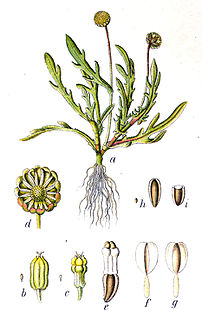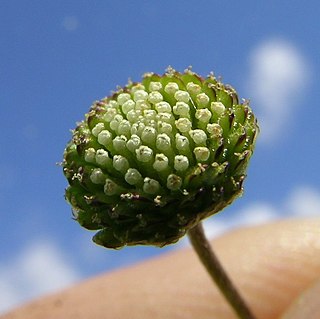
Leucanthemum vulgare, commonly known as the ox-eye daisy, oxeye daisy, dog daisy, marguerite and other common names, is a widespread flowering plant native to Europe and the temperate regions of Asia, and an introduced plant to North America, Australia and New Zealand.

The small marsh flower Cotula coronopifolia bears the common names brass buttons, golden buttons, and buttonweed. The flower heads are bright yellow discoid heads that look like thick buttons. Individual plants spread stems along the ground and send up the knobby flowers at intervals. The plant is native to southern Africa, as well as New Zealand, but it has been introduced to other parts of the world.

Anthemis cotula, also known as stinking chamomile, or mayweed, is a flowering annual plant with a noticeable and strong odor. The odor is often considered unpleasant, and it is from this that it gains the common epithet "stinking". In pre-colonial times, its distribution was limited to the Old Continent and Africa; though it was established in most of Europe, it was not present in Finland, Ireland, or the northernmost reaches of Scotland, in spite of the fact that these countries feature climatic regions favorable to this plant and are in proximity to countries where the species is native, such as Russia, Estonia, Lithuania and England. It has successfully migrated to the New Europes where it can be found growing in meadows, alongside roads, and in fields.
Dog fennel, dog-fennel, or dogfennel is a common name for several plants and may refer to:
Cotula moseleyi, also known as Nightingale brassbuttons, is a species of flowering plant in the sunflower family. It has been found only in the Tristan da Cunha chain of islands in the South Atlantic Ocean. Its natural habitats are subantarctic forests, subantarctic grassland, rocky shores, and hillsides. It is threatened by habitat loss.

Cotula is a genus of flowering plant in the sunflower family. It includes plants known generally as water buttons or buttonweeds.

Cotula australis is a species of plant in the daisy family known by the common names bachelor's buttons, annual buttonweed, southern waterbuttons and Australian waterbuttons. This small plant is native to Australia and New Zealand, but it is known in other areas of the world as a common weed.

Anthemideae is a tribe of flowering plants in the family, Asteraceae, and the subfamily Asteroideae. They are distributed worldwide with concentrations in central Asia, the Mediterranean Basin, and southern Africa. Most species of plant known as chamomile belong to genera of this tribe.
Mayweed is a common name for two different species of flowering plants and also a name commonly used for several genera of the tribe Anthemideae whose species are currently in a flux of renaming:

Leptinella is a genus of alpine flowering plant in the family Asteraceae, comprising 33 species, distributed in New Guinea, Australia, New Zealand, South Africa, and South America. Many of the species are endemic to New Zealand.

Aethes smeathmanniana, or Smeathmann's aethes moth, is a moth of the family Tortricidae. It was described by Johan Christian Fabricius in 1781. It is found in most of Europe, Asia Minor and in North America, where it has been recorded from New Jersey and Newfoundland and Labrador.
C. pectinata may refer to:

Cape Lowland Freshwater Wetland is a critically endangered vegetation type of the Western Cape, South Africa.
Cotula is an unincorporated community and coal town in Campbell County, Tennessee. It was also known as Gatliff. Their post office is closed.
Buttons may refer to one of several genera of plants in the family Asteraceae:
Cotula mexicana, also known as Mexican brassbuttons, is a plant species in the sunflower family. It is widespread in South America and also found in central Mexico and parts of the United States.

Cotula alpina, also known as the alpine cotula, is a perennial herb in the family Asteraceae. It is a small flowering plant that forms ground covering mats and is well adapted to alpine environments.

Leptinella filiformis, or slender button daisy, is a species of flowering plant in the daisy family, found only in the north-eastern part of the South Island of New Zealand. Thought to be extinct by the 1980s, it was rediscovered growing on a Hanmer Springs hotel lawn in 1998, and in the wild in 2015.

Cotula turbinata is a herb in the Asteraceae family native to the Cape Province, but found in India and in Australia












